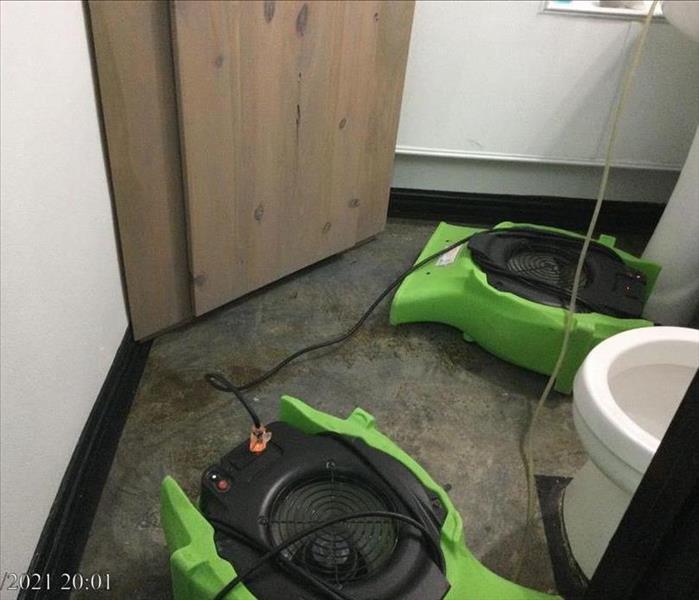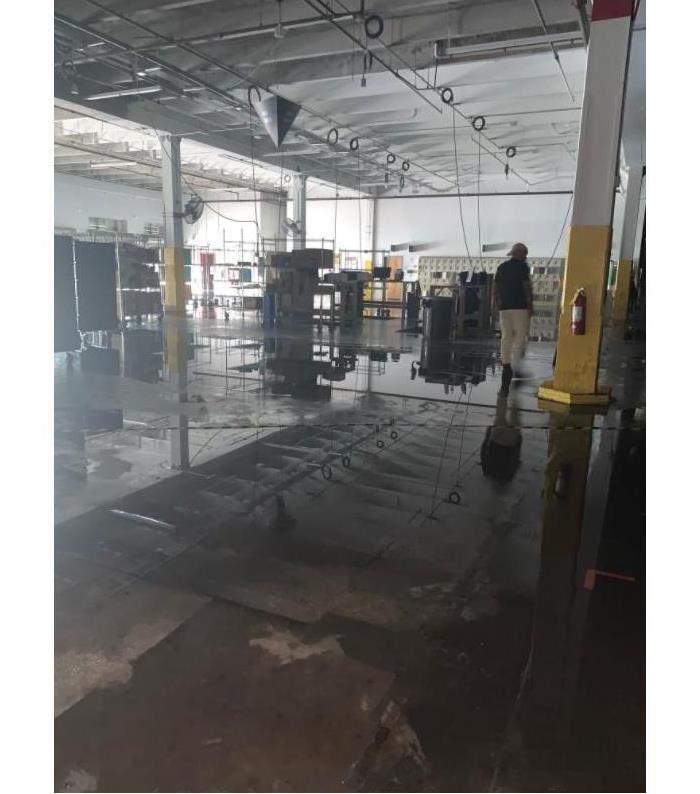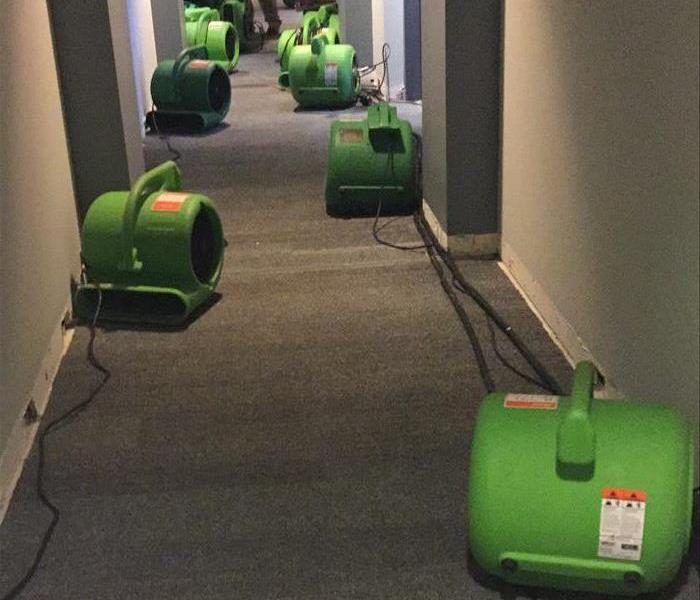Recent Storm Damage Posts
How To Prevent Mold After Water Damage
3/1/2021 (Permalink)
 Air Blowers drying water damaged space
Air Blowers drying water damaged space
Water damage restoration services in Coral Gables, FLAfter experiencing water damage at your business in Coral Gables, FL, you should do everything you can to prevent mold growth. These tips will help you clean up standing water and prevent molding.
Steps
To prevent molding, you should perform the following steps as soon as possible:
- Remove standing water
- Dry the area
- Disinfect surfaces
Without quick mitigation, mold will grow within 24-48 hours of a flood, so you have to act quickly.
Removing Water
You must first remove water from the building. How this is done depends on the amount of water present. If there is only a small amount, you may be able to clean it up with towels, a mop, or a wet-dry vac. If there is an excessive amount of water, you will likely need pumps or industrial vacuums. You should also make sure the liquids are not in contact with any electrical wiring or contaminated with any harmful bacteria. If there are excessive amounts of water, an electrocution risk is present or that water is contaminated, you should call a water damage restoration service to assist you.
Drying the Area
Opening doors and windows will help dry the area more quickly. Once the bulk of the water and any wet items have been removed, you can set up fans to aid in the drying process. Fully drying the area will prevent mold growth and further damage.
Disinfecting Surfaces
After surfaces are dry, they must be disinfected to kill bacteria and prevent the growth of mold. Any surface that the water touched should be thoroughly disinfected, including flooring, furniture and belongings.
Flooding can cause mold growth in addition to other types of water damage. To mitigate the development of mold, you should remove standing water, dry the area completely and thoroughly disinfect surfaces. If there are excessive amounts of water or risks of electrocution or contamination, you should contact a professional to help clean up and repair the damage.
Is Your Building Prepared for a Wind Event?
11/9/2020 (Permalink)
 SERVPRO of West Miami Technicians reviewing water damaged commercial facility.
SERVPRO of West Miami Technicians reviewing water damaged commercial facility.
Is Tropical Storm Eta heading towards the Coral Gables? - Prepared for a Wind Event?
Tropical Storm Eta is expected to miss Coral Gables, FL, however, powerful winds can cause significant damage to buildings and homes. Broken windows, leaks and residential roofs damaged or torn partially or completely off.
Assessing Your Risks
While buildings are constructed to withstand strong winds, there are still steps that a building owner can do to ensure that your property does not suffer significant damage during a catastrophic wind event.
Downtown Miami including neighborhoods like Wynwood and Midtown Miami may experience high winds from Tropical Storm Eta which can cause damage to your property.
Protect Your Roof
Whether you are in a residential home or a commercial building you should conduct regular roof inspections. Examine the roof for any loose or missing materials or loose perimeter flashing. During a large wind event loose flashing can cause water to seep inside causing a potential interior flooding. When inspecting a commercial rooftop make sure there is no loose equipment and all entries and doors are secure.
Inspect Areas Surrounding Building
Having lawn furniture, pool lounge chairs, planters can all become a wind hazard, so be sure to remove or secure anything that may become a projectile. Remove any loose items, or any other debris before high wind storms. You should consider replacing gravel or rock landscaping with shredded materials. Gravel landscaping materials are a major source of windborne debris and can cause significant damage as they can break unprotected windows.
Create and Test a Disaster Response Plan
Having a response plan in place will ensure that when a wind event occurs, you and your team will be prepared that the property will be protected. While many have a disaster response plan in place, it’s vital to also test the plan. Ensure that all staff is aware and educated about all wind-related procedures. You local SERVPRO of Wynwood can help you with setting up you plan with you own custom Emergency Ready Plan - ERP.
Be Prepared
The main takeaway is to be prepared before any wind event. By following the above tips and taking steps to secure your building, you can make sure that your building will be safe and protected from damage in the event of a catastrophic wind event and potential flood repair efforts.
Storm Flood Damage - What to Expect After the Storm
10/27/2020 (Permalink)
 Commercial Office flood damage, cleanup and restoration
Commercial Office flood damage, cleanup and restoration
Types of Damage To Expect After Storm Flooding
10/27/2020 (Permalink)
Commercial water damage in West Miami, FL
Storm Damage That Can Affect Your Business
After a heavy storm in the commercial downtown Coral Gables, FL area, you may find your business has issues due to flooding which can result in water damage, mold growth, and wind damage. Fortunately, a local storm damage restoration service can help. Here’s what you may want to know about these three types of damage and how they can affect your business.
1. Water Damage
One of the first damage types associated with storms comes from water. Standing water can lead to the growth of bacteria and mold which have their own types of problems. It can also seep into the structure and lead to crumbling drywall, cracked tile, soften stone, and warp wood such as that in flooring or support beams. Fortunately, removing the water quickly may help mitigate large scale damage. A pump may be helpful in this process.
2. Mold Damage
Another type of damage comes from mold growth. Mold can grow when an environment is left damp for an extended period of time, often in areas of water damage. It roots into organic materials such as drywall and spreads by sending out spores. Mold colonies can weaken the structure around their growth.
3. Wind Damage
Another type of damage that can be seen after a storm comes from the winds. Most often people think of the damage the wind can do to a roof if there are any loose shingles. However, the wind can also pick up loose debris such as small stones, branches, or items left on the law, and blow them into the structure. Additionally, the wind can tear loose any overhanging branched from nearby trees.
After a storm, you can expect to see water damage, damage from mold growth, and damage caused by high winds. Your local restoration team should be able to assess and repair each of these damage types, and soon have the company property looking “Like it never even happened.”






 24/7 Emergency Service
24/7 Emergency Service

